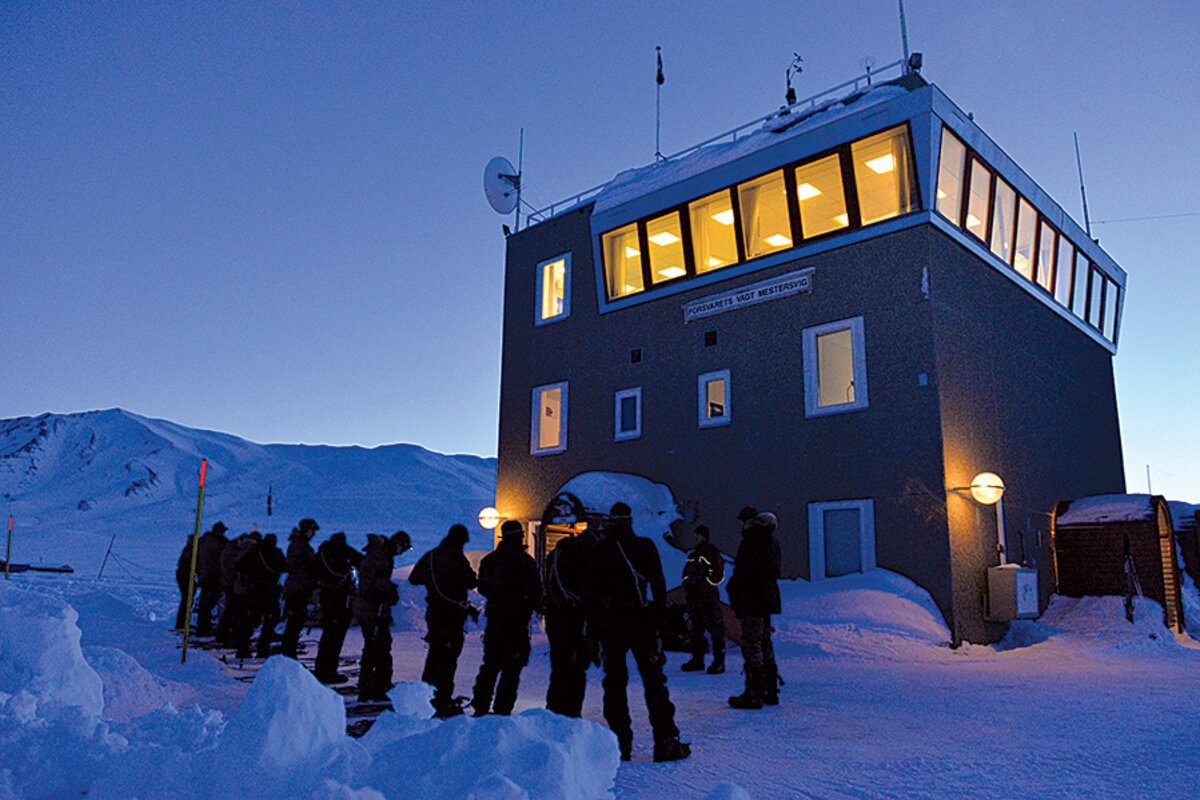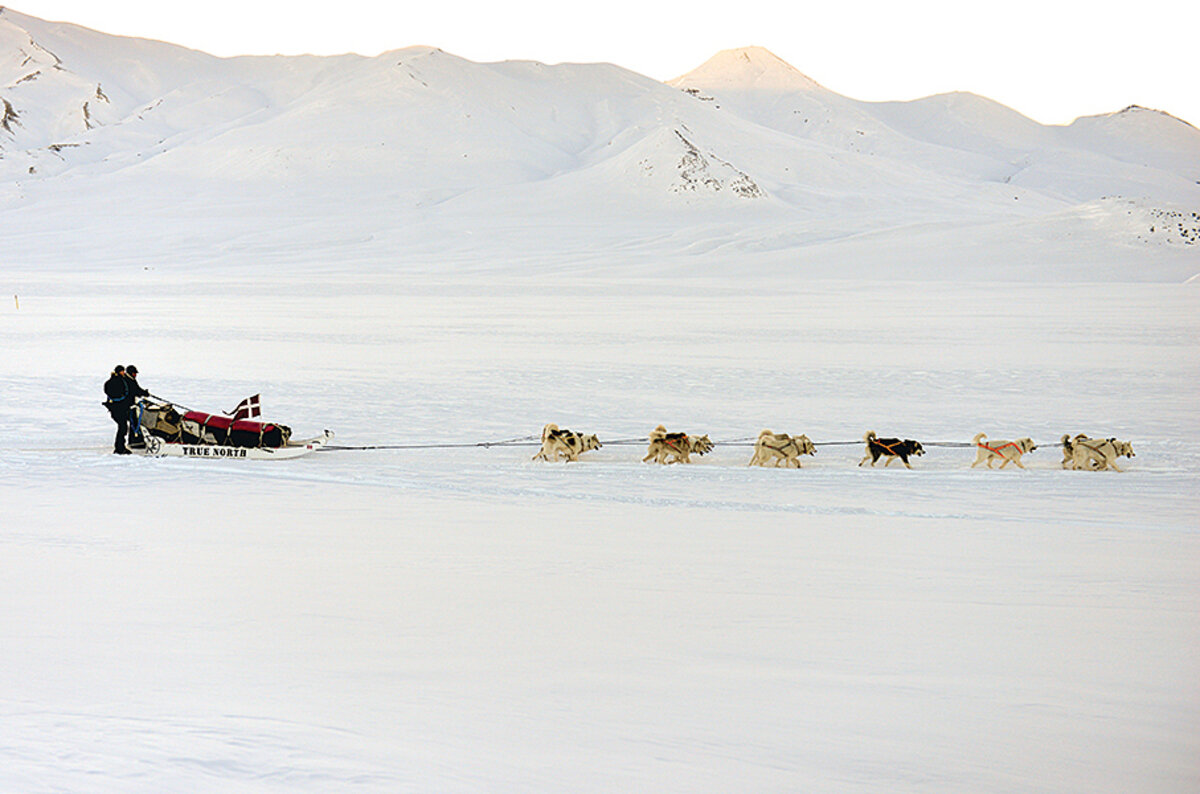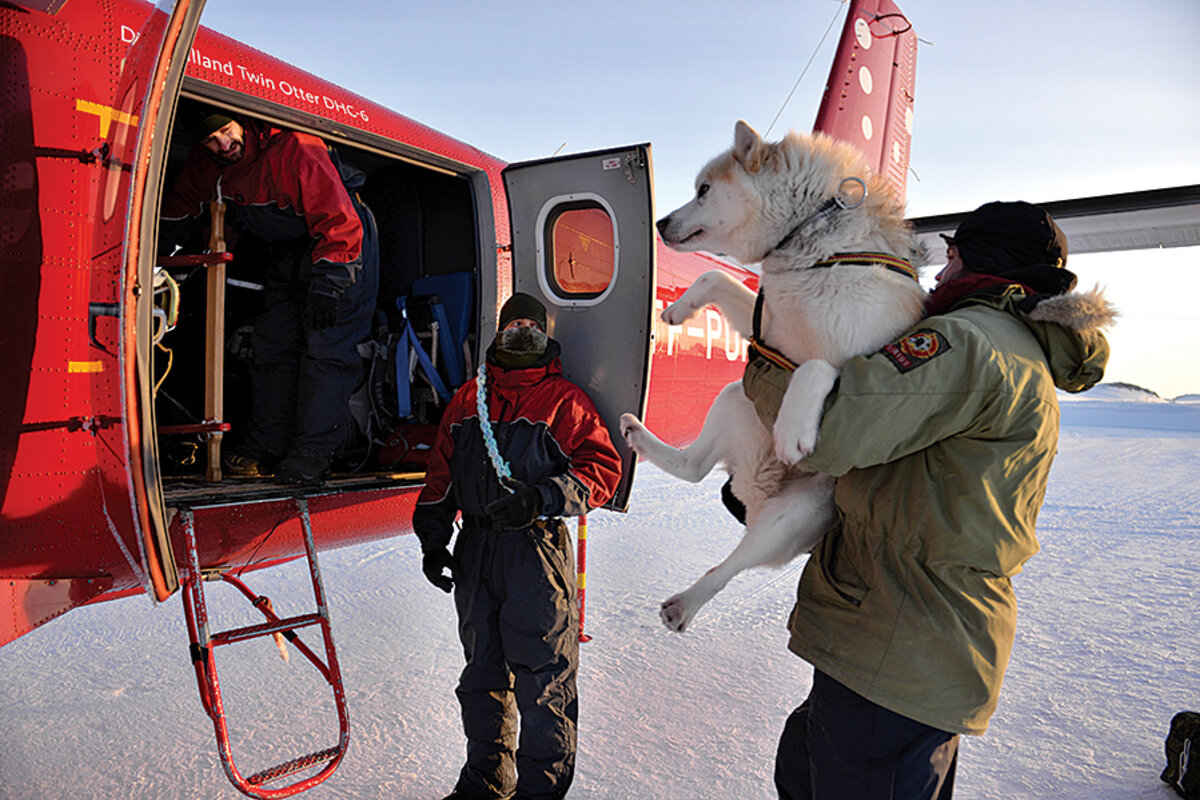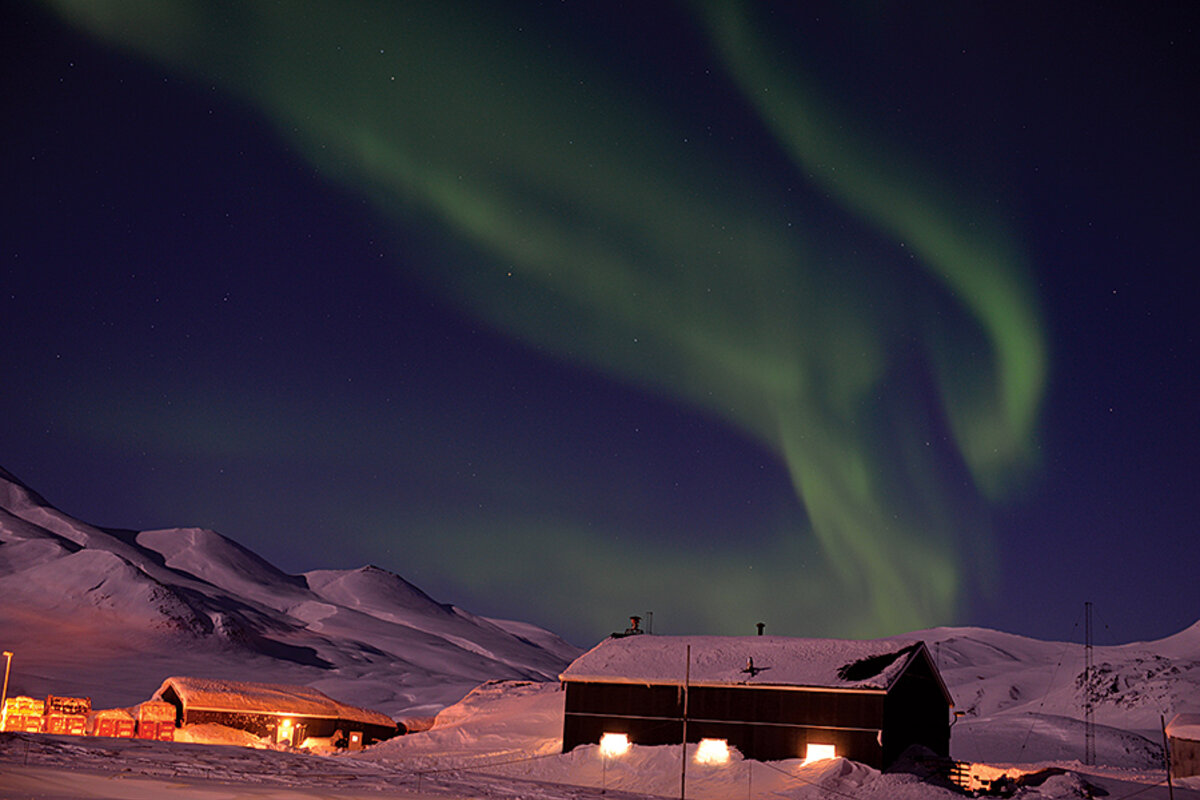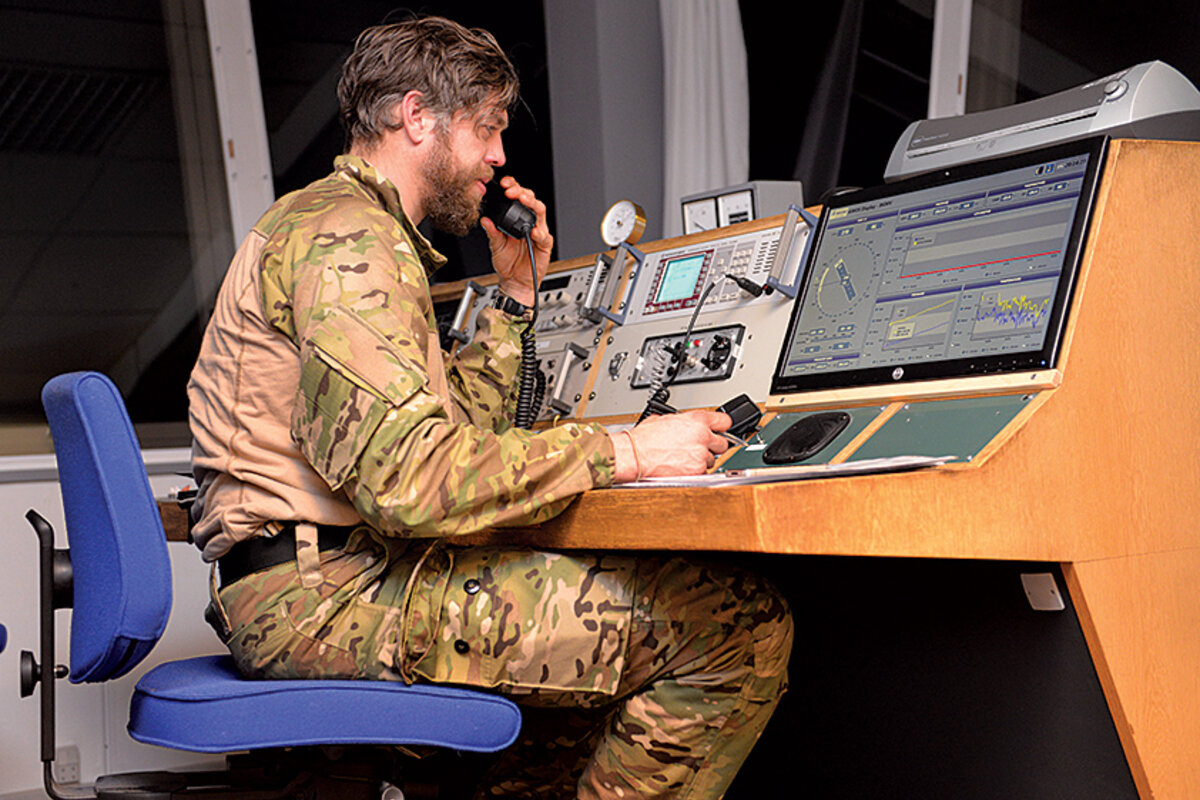The world's most unusual military unit
Loading...
| Mestersvig, Greenland
Anders Kjærgaard and Frank Pedersen, officers in the Danish military, were out on routine patrol using an unusual form of transport – a dog sled. Suddenly, they hit a stretch of soft snow while traveling across a frozen fjord in Northeast Greenland. The men were navigating a 160-mile route they had traversed several times before. Only this trip, in January, came after the warmest year on record near the North Pole.
Within seconds, the sled dogs sank to their chests in an enclosing tomb of gelid slush. Mr. Kjærgaard and Mr. Pedersen quickly started unloading supplies to lighten the load. Water seeped into their insulated boots. They knew they had to work fast to avoid getting frostbite.
After half the weight had been removed, the men packed down a path in the snow for the dogs. The team heaved and clawed for traction. Slowly, they proceeded a half mile, then stopped. The men removed the remaining weight from the sledge, turned the team around, and retrieved the supplies left behind. They did this for two days – back and forth, back and forth, occasionally stopping to change into dry boots, socks, and clothes. Finally, they reached solid land.
“That was a bad day at the office,” says Kjærgaard. “A hard discipline, one of the worst things I’ve ever experienced up here. But there’s no one there to help you, and your body knows that as well. You just have to continue.”
While most soldiers around the world worry about the dangers of war, members of Denmark’s unique Sledge Patrol Sirius face a different set of challenges – cryogenic winds, quaggy glaciers, frostbite, and polar bears.
The territory they monitor is wild, inhospitable, desolate – no place for humans. In late November the sun slides below the horizon and doesn’t rise again until the end of January. During the long polar night unforgiving winds lash the vast and vacant expanses. Temperatures plummet to 40 degrees below zero and lower. Not even the Kalaallit (Greenlanders) come to this area they refer to as Tunu, the back. In the entire region, which is more than four times the size of the United Kingdom, fewer than 30 people live at any given time. Twelve of these are the men who make up one of the world’s most unusual military units – an elite force that has become increasingly important as the world’s industrialized powers rush to gain a toehold at the top of the world.
• • •
Since 1953 the Sirius Patrol has operated under its original mandate – to enforce Denmark’s sovereignty in this territory that lies entirely above the Arctic Circle. The unit’s origins can be traced to a decree issued in 1933 by the League of Nations’ Permanent Court of International Justice, which settled a longstanding dispute between Norway and Denmark over which country could claim Greenland. The court ruled in Denmark’s favor but required it to maintain a continual presence in Northeast Greenland thereafter.
In 1974, the area – now about 375,000 square miles, roughly one-quarter of the island country – was designated the Northeast Greenland National Park, making it the world’s largest and northernmost protected wilderness. Since then the patrol’s duties have expanded to include policing the park, supporting visiting scientists and researchers, and helping a small but growing number of tourists.
But their primary mission, and the one for which they are most celebrated, is to patrol the 8,900-mile coastline – a task that even today is best achieved by dog sled.
Since the demise of the cold war, this has been a relatively innocuous exercise – just the Sirius men and their dogs pitted against the formidable elements. (And they are all men – women are invited to apply but none has in the history of the sledge patrol.) However, as the region becomes a new nexus of geopolitical tension, their policing authority has taken on greater urgency. The United States, Russia, and much of the developed world, including non-Arctic nations such as South Korea, Japan, Italy, and China, want access to sea lanes that are eventually expected to open each summer in the Arctic Ocean.
These and other countries, including Germany, India, and Brazil, are also vying for a claim to the region’s vast cache of oil, gas, and mineral wealth. Warming temperatures and developments in technology may open opportunities for exploration and extraction of the nation’s resources that have long proved economically elusive. Meanwhile, each year more scientists arrive to study the meteorological significance of Greenland’s climate and massive retreating ice sheet.
Tourism, too, is on the rise as the country increasingly becomes a destination for kayakers, climbers, cyclists, and other adventurers seeking access to some of the world’s least trammeled mountains and pristine waterways.
Developments in energy and tourism are potentially good for Greenland’s overall economy and drive for full independence from Denmark. The former colony gained home rule status in 1979 and greater autonomy through the Act on Greenland Self-Government in 2009, yet remains heavily subsidized by Copenhagen. But such developments have put new pressure on the 12 Sirius patrolmen who function as the region’s sole police and military force.
In February, the US Embassy in Copenhagen arranged a diplomatic mission to Northeast Greenland, led by the American ambassador to Denmark, Rufus Gifford. Embassy officials offered me the opportunity to tag along. I gathered up my warmest clothes and set out for the Danish air base in Aalborg, where I was instructed to meet the ambassador for the trip north.
Greenland has become increasingly important to Mr. Gifford’s work since the US became the chair of the eight-nation Arctic Council in 2015. Sirius commanders had decided that the best way for Gifford to better understand the region was to take him out on the ice with the men and their dogs.
“The international community – and certainly the US and Denmark – has an interest in keeping this part of the world as safe and pristine as possible,” Gifford tells me on the flight from Aalborg to Mestersvig, a military outpost on the southern shore of Northeast Greenland National Park. “If there are economic opportunities, we are not going to close our eyes to that. We can pursue economic possibilities in an environmentally responsible way. [The US and Denmark] will work with the government of Greenland to see whether or not there are potential opportunities for mining and drilling.”
I strike up a conversation with 1st Lt. Anders Sejersen, seated across the aisle. Dressed in Army fatigues, squared-jawed and fit, Sejersen is unmistakably Nordic and speaks in the measured words of a man well inured to silence. Like most Danes, he grew up hearing stories about the nationally revered Arctic dog-sled unit. But it wasn’t something he’d considered for himself until after he was already in the military. “I was enrolled in a course with officers from Sirius. They talked so much about the unit that it sparked my interest,” he says. “After the course, I began thinking about Sirius, reading up on it, and so on – then I knew.”
Sejersen served as a Sirius officer from 2005 to 2007. In 2012, he returned as the unit’s leader. Today he is based at the Joint Arctic Command headquarters in Nuuk, the capital of Greenland, where he oversees Sirius’s land operations. I ask Sejersen what drew him to Greenland initially and still intrigues him today.
“The nature impresses me a lot. I still remember the first time I landed up here – it was amazing to see the mountains, the ice, everything.” He looks out the window of the Danish Air Force Gulfstream and turns back to me, his eyes suddenly alight. He motions for me to look for myself.
Below, icebergs the size of frigates are locked in place and cast quarter-mile shadows across the glinting ice. Our plane passes over serrated mountain peaks and circles Mestersvig. From the air, the station looks like an architect’s scale model in the immense landscape, just a handful of low-lying buildings and cargo containers half buried in snow. As we descend, I notice eight men standing in formation along the landing strip – members of the Sirius Patrol.
Hours after my arrival, I go to the station canteen, where 12 young men, all new applicants to the unit, are busy in the kitchen or setting the table for dinner. Eight of the cadets are applying to join the patrol and four hope to become station specialists, providing support for the dog-sled teams.
The men have been in Greenland for nearly a month to complete their winter survival course, a component of the patrol’s training program called forskole (preparatory school). The forskole takes place annually and includes courses as varied as engine mechanics, advanced first aid, radio and communications, firefighting, shooting, basic dentistry, carpentry, and even – or especially – cooking and sewing. Since the officers will often be away on long patrols, it is important that they be well trained to meet any eventuality.
Yet they have to learn far more than how to darn socks and pull a tooth. The men must also endure a three-day survival trek into the wilderness, which begins by jumping into freezing seawater through a hole blown into the five-foot-thick ice by dynamite. As the instructors and a medical doctor keep watch, each man has to swim to the edge of the opening, pull himself from the freezing slush, strip naked, and change into dry clothes. From there the recruits march into the mountains to dig snow caves for shelter and build huts from blocks they carve from the snow. Each is given seven ounces of chocolate as his only sustenance for the duration of the exercise.
I sit down with Sgt. Frederik Oxlund, the current leader of the forskole. In July Oxlund will replace Kjærgaard as the commander of the Sirius Patrol. Beside him sits 1st Class Sgt. Jens Bonde, a former Sirius patrol officer who is in Mestersvig to help oversee the cadets’ training. Oxlund, copper-haired and thoughtful, explains that most of the forskole’s sessions require that the men work as a team or in pairs. This prepares them for their time on the ice, which begins in early November and extends into June. During that span, six teams, each composed of two men with 11 to 13 dogs, patrol as many as 40 miles a day of the park’s coastline. They scout the coves and capes of the park’s fjords, sleeping most often on the ice in simple cloth tents with no insulation.
They are equipped with radios, a satellite telephone, compasses, and maps. But like the wooden sleds the men fashion by hand, the unit relies on technology that hasn’t changed greatly from its earliest days, simply because most high-tech devices and fabrics cannot be relied upon in the extreme cold. A snowmobile’s engine can malfunction easily while the ancient Kalaallit Qimmiat (Greenland dog) is suited to withstand subzero temperatures. Wool has proved to make better base layers than polypropylene and other “miracle” synthetic blends. Even the guns the men carry are a modified relic from World War I, the US Army-made M1917 Enfield. The 100-year-old bolt-action rifle turns out to be the most effective way for the officers to protect themselves from polar bears. More sophisticated guns jam in the cold.
“The first year, one is a trainee and everything is exciting,” Oxlund tells me. “The winter course prepares the trainee, helps adapt him to the cold.” A new recruit is paired with an officer who has at least one year of experience on the ice. “Then the next year, he’s the lead and has the responsibility of the apprentice.”
Until recently the Danish military required that the men be single. Although the restriction has been somewhat loosened, candidates, as one officer puts it, must “have their family relations in order” – returning to Denmark is not an option during the 26-month tour in Greenland.
The men spend up to five months on the ice without a break. They do everything together. “You go out with your partner, who you think you know, but you’re only starting to know him,” Bonde says. “When you’re out there, it’s more or less like a marriage, because you get very close. You know how your partner takes his coffee and so on.” But that doesn’t necessarily mean that the two will end up being good friends. “That [only happens] if you’re good at letting one another in. Sometimes it goes well, and other times it’s just like a marriage [in which partners] say only good morning and good night.”
Nevertheless, Oxlund adds, “We’re still professional soldiers. You may go three months without talking. That doesn’t matter. We make it work.”
Amid the unforgiving conditions, the men learn to focus on what’s directly in front of them. Inattention can lead to accidents and possibly death. They learn something else, perhaps their most valuable lesson – that the survival of one depends on the survival of the other. Time on the ice hacks away at the illusion of separation; detachment proves impossible.
“Everything becomes routine,” says Oxlund. “It’s just work. It’s pretty much the coolest thing ever.”
Lars Rindom, a brawny, russet-bearded station specialist seated beside me, agrees. “There’s a lot of work. We work all the time, even Sundays which are supposed to be days off,” he says. “But when you do something you like, it’s like a holiday. Here we have clean snow. It’s the same as a beach.”
The next morning Bonde and I travel by snowmobile to visit Gifford and Kjærgaard, who had already gone out with Sledge Team 7, on the frozen plate of Kong Oscar Fjord. At 24 degrees below zero, the rush of cold air needles the wool balaclava drawn over my head and stings my face. I huddle behind the shield of Bonde’s hunched frame as he drives. I look down, considering the ice beneath us. I’d listened to the officers’ stories and knew that the sea ice in February is nearly five feet thick in most places and carries almost whatever it is given – men and dogs, packed sleds, even Twin Otter airplanes fitted with ski runners – but my doubt, ingrained by cautionary tales, persists. The hardened surface over which we are gliding is a meteorologically produced illusion, constantly shifting, and now threatened by increasingly unpredictable weather patterns.
At 8 a.m., it is still dark, but far across the ice a bright band of red-gold illuminates the sharp peaks of Traill Ø, signaling that the sun – which gains 20 minutes a day over the darkness at this latitude – will soon rise. The cold is shocking. “If your fingers start to go numb, swing your arms until the blood shakes back down into your hands,” Bonde had instructed before we’d set out from Mestersvig. “The cold sneaks up on you. You have to stay focused.” I windmill my arms, but my fingers continue to burn.
Bonde stops the snowmobile. He scans the horizon for Sledge Team 7. Over the muffled thrum of the engine, there is no sound, no movement, not even wind. We are alone, immeasurably dwarfed in the enormous silence and indifferent landscape, a realization that suddenly feels freeing and oddly comforting. For a moment I understand and envy the men of Sirius.
Then, a scintillating arrow of light arcs through the darkness, dips, and disappears. “There,” Bonde says and angles quickly in the direction of the fallen flare. The men’s campsite comes into view. Their tent, lit from within by a lantern, looks like a gold luminary flickering on the darkened plain. The dogs are asleep, curled into tight puffs of fur, until they hear the snowmobile’s engine. They jump up and bark, jerking at their leads. Kjærgaard watches us approach.
When we pull up, he smiles. “Come inside. I’ve made coffee.”
Inside, Gifford sits on top of his sleeping bag. He is clearly tired and cold, but he’s also beaming. “I had less than an hour of sleep, and even that was interrupted. I kept waking up because my feet were so cold – but what a night! Did you see the northern lights in Mestersvig?” he asks. Kjærgaard and Gifford had sat out on the ice with the dogs and watched as the tendrils of green light undulated across the night sky.
At 6 feet, 4 inches, Kjærgaard has the stature and shoulder span of Thor, the mythical hammer-wielding Viking god. In the faint light, he appears impervious to the great cold, despite a small coin of roughened red skin on his upper left cheek – a remnant of a bout of frostbite in 2010 that had been reactivated during a sledge trip three days before.
“I’ve stopped resisting the cold,” he claims as he hands me a cup of steaming coffee. “Bad weather comes and you wonder why you’re here, but then that passes. Here, you just work all the time. Suddenly half a year is gone.”
Kjærgaard dropped out of university when he first applied to the patrol in 2008. After serving with Sirius from 2009 to 2011, he returned to Denmark, where he finished his master’s in psychology. He worked for a year. But, like Sejersen, a longing for Greenland burned within him. “It was so very strong,” he tells us. “I needed to come back.” So, Kjærgaard returned on a two-year contract, first as the head instructor of the forskole and then the unit’s leader.
In his 3-1/2 years in one of Earth’s last unpopulated areas, Kjærgaard has witnessed an influx of visitors. “It’s feeling more crowded. There’s a lot of focus on the Arctic now,” he says. “Each summer, as soon as the ships can sail, tourists come. It’s a hot topic, because what could be done if they hit an iceberg? We couldn’t do anything. We’re 12 men. We have two boats.”
He and the other patrolmen are frontline witnesses to changes in the region’s environment. Kjærgaard says that it may still be too soon to say if recent climate changes are permanent. Yet the Danish Meteorological Institute announced in mid-April that almost 12 percent of the Greenland ice sheet was already covered with a layer of meltwater – a month earlier than the agency had ever seen meltwater on that scale. Given his recent ordeal with soft snow and slush in the heart of winter, Kjærgaard acknowledges that something is happening.
“Fifteen years ago, sledge teams had to be back from their tours on the ice by mid-June. Nowadays, we need to be back by the beginning of June,” he says. “This could imply that the ice is melting earlier, that the great ice is diminishing. So we will encounter more polar bears each year.”
The great sea ice that encircles North and Northeast Greenland is the traditional hunting ground for polar bears. Earlier and longer thaws mean that the bruins must come on land to forage. “Last year we had to kill two, which is not normal,” he says. I ask Kjærgaard why he came to Greenland in the first place and longed for it when he left. “The job is a challenge. When you are faced with such challenges, you learn a lot about yourself,” he says. “And when you lie in a snow cave with six other guys with nothing to eat, you learn a lot about others. The team becomes a family. I don’t think of it as work. Ninety percent of us would likely do this without being paid.”
“What comes next for you?” Gifford asks.
“I don’t know. You either love it or hate it up here,” he replies. “I love it. For now, though, this is it with Sirius for me.”
Kjærgaard finishes his coffee and looks up. “The sun’s coming. Shouldn’t we get going?”





